Wine Lister’s latest MUST BUY update identified 38 new wines that show quality and value within their respective vintages and appellations, and wide praise from the international trade. To help you discover these new picks, this week’s blog takes a deep dive into the latest MUST BUY wines and their geographical composition.
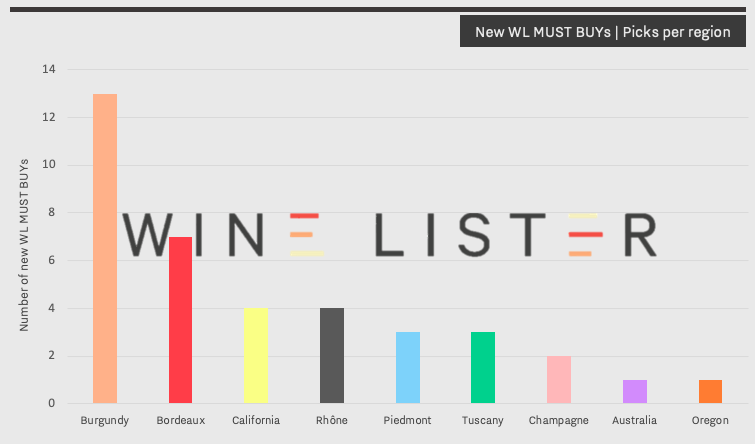
Pinot Noir picks
Burgundy dominates the new MUST BUY hoard with 13 entries, including eight reds. The perfect pick for an opulent occasion, the 1978 Romanée-Conti Richebourg costs £1,434 per bottle (in-bond), and was described by Wine Lister partner critic, Jancis Robinson, as “very long with smoothness, sweetness and unctuousness”. Sharing its WL score of 96, the 2010 Volnay Clos des Ducs from the Côte de Beaune’s red producer of reference, Marquis d’Angerville, provides a more affordable option at £250 per bottle (in-bond), but may merit a little patience.
Outside of Pinot Noir’s original homeland are some new MUST BUYs of brilliant quality and impressive value for money. California’s 2016 Au Bon Climat Isabelle Pinot Noir has a WL score of 94, and was described by Wine Lister partner critic, Antonio Galloni, as “racy, perfumed and beautifully layered”, with notes of “orange peel, tobacco, blood orange, spice, star anise and new oak” throughout. It can be purchased for less than five times the price of the aforementioned Volnay, by the case of six for £262 (in-bond) from Jeroboams.
Travelling north within the US brings us to Oregon’s latest MUST BUY entry – the 2016 Cristom Louise Vineyard Pinot Noir. While more expensive than its Californian counterpart for the same WL score, Cristom’s position as the leading producer in the Willamette Valley, alongside its closer proximity to Burgundy’s cool-climate restrained style, makes it more than worth the c.35% premium. It is available to purchase for c.£60 per bottle (in-bond) from WineBuyers.com.
The best of Bordeaux blends
Bordeaux offers seven new MUST BUYs this week, including two Left Bank Value picks; 2019 Haut-Bages Libéral and 2015 Capbern. With a WL score of 92, the former addition was released en primeur two months ago, and described by James Lawther for JancisRobinson.com as, “busy and expressive on the nose with vineyard-fresh dark fruit, black-olive and mineral notes”. Labelled by Lawther as the “best in recent years”, this gem from Bordeaux’s prominent promotors of biodynamic viticulture, Gonzague and Claire Lurton, has a bright future ahead. It can still be bought en primeur through Justerini & Brooks for £142.50 per six (in-bond).
The 2010 Vieux Château Certan also appears in the latest MUST BUY update, 10 years on from the iconic vintage. It provides a more lavish option for the Bordeaux buyer, receiving a WL score of 96 at £216 per bottle (in-bond). Moving across the border into Tuscany, the 2010 Sassicaia also offers a more luxurious alternative to the Bordeaux blend. Comprising of 85% Cabernet Sauvignon and 15% Cabernet Franc, it was described by Antonio Galloni as, “just beginning to show the first signs of aromatic development”, including hints of “sweet tobacco, mint, pine, dried cherries and licorice”. It achieves a WL score of 95, and is available to purchase by the case of six for £915 from Goedhuis & Co.
Choosing Chardonnay
Back to Burgundy, and the new white MUST BUYs this week offer opulence from three iconic Meursault producers; 2015 Roulot Charmes, 2010 Comtes Lafon Genevrières, and 2017 Arnaud Ente Les Petits Charrons are all exceptional choices, albeit for an average price of £492 per bottle (in-bond). Further north, two entries hail from Chablis, and the appellation’s original historic vineyard, Les Clos; 2014 Laroche Les Clos, and 2010 Christian Moreau Père et Fils Les Clos. For those who enjoy a more pure, lean, and mineral style of white wine, the Chablis MUST BUYs exhibit notable value within their appellation and achieve higher WL scores than their buttery Meursault counterparts. The latter can be bought by the case of 12 from Cru World Wine for £871 (in-bond).
California’s latest white MUST BUY hails from Kistler Vineyard; a cult producer known for its emulation of pure and balanced Burgundian Chardonnays, over the rich and oaky Californian style. The 2017 Kistler Vineyards Dutton Ranch Chardonnay achieves a WL score of 96, and is labelled by Antonio Galloni as “such an intriguing wine because of the way it is airy and lifted and yet also so deep in feel”. Providing a less expensive alternative to Côte d’Or whites, it is priced at £133 per bottle (in-bond).
Also featured in the list of new MUST BUYs are: 2009 Abreu Madrona Ranch Cabernet Sauvignon, 1989 Bollinger Grande Année, 1996 Bruno Clair Chambertin Clos de Bèze, 2006 Cavallotto Barolo Vignolo Riserva, 2013 Ceretto Barolo Brunate, 2012 Conti Costanti Brunello di Montalcino Riserva, 1996 Dunn Vineyards Howell Mountain Cabernet Sauvignon, 2014 Duroché Chambertin Clos de Bèze, 2017 Georges Mugneret-Gibourg Clos de Vougeot, 2012 Jacques-Frédéric Mugnier Chambolle-Musigny Les Amoureuses, 2014 Jean Grivot Richebourg, 2010 Jim Barry The Armagh Shiraz, 2017 Joseph Drouhin Chambolle-Musigny Les Amoureuses, 1996 Lafite Rothschild, 2008 Lafleur, 2016 Le Macchiole Paleo Rosso, 2016 l’Evangile, 2006 Louis Roederer Cristal Rosé, 2018 Marc Sorrel Hermitage, 2013 M. Chapoutier Hermitage Ermitage Blanc De l’Orée, 2016 M. Chapoutier Hermitage Ermitage Le Méal, 2012 Roagna Barbaresco Pajè Vecchie Viti, 2016 Valandraud, and 2009 Vincent Paris Cornas La Geynale.
Many wine lovers like us have been making the most of lockdown to explore outside of the more traditional wine-growing regions and grape varieties. Wine Lister’s new cellar analysis service can include tailored guidance on future purchases for drinking or investment, providing recommendations for top-quality wines from alternative producers and regions.
To help you discover some of these brilliant New World picks, the Wine Lister team has put together a short selection of MUST BUYs that have exhibited a recent rise in popularity, as established through search frequency data from Wine-Searcher.
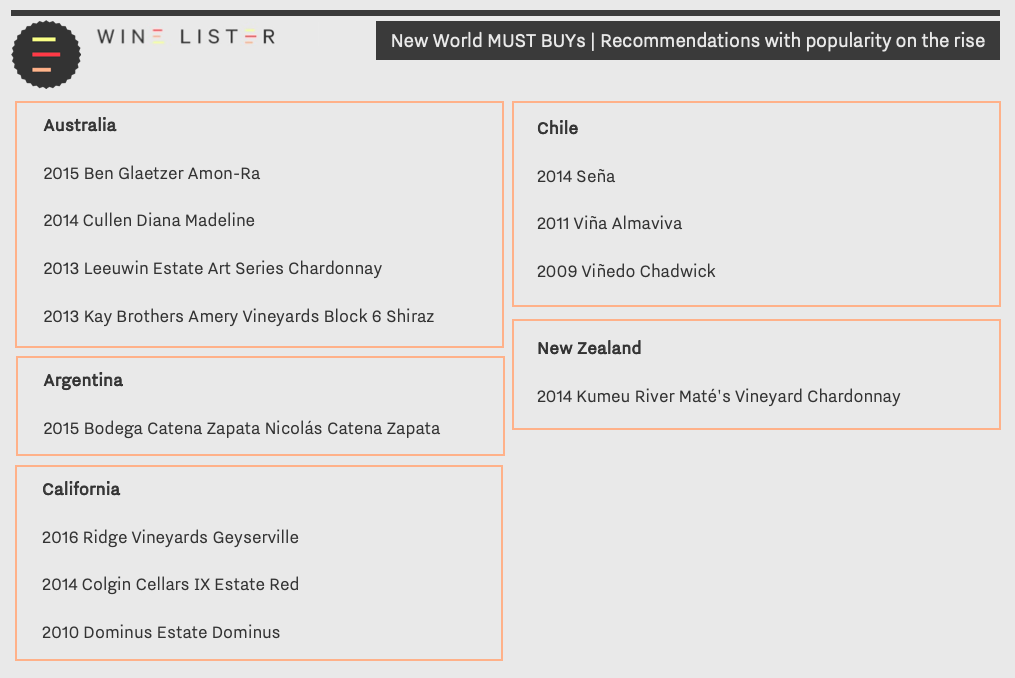
Australia to ask for – 2014 Cullen Diana Madeline
Founded in 1971, the Cullen Estate has maintained concern for its environment since its inception, keeping both chemical intervention and irrigation to a minimum. In 1998, the estate adopted an organic viticulture, which was further developed into a biodynamic practice in 2008. Winemaker, Vanya Cullen, states the biodynamic approach to harnessing Earth’s energy “achieves greater individuality of site through working with nature rather than against it”, suggesting its ability to better display terroir and climate. The estate’s flagship wine, Diana Madeline, comprises a blend of 89% Cabernet Sauvignon with small amounts of Petit Verdot, Merlot, Malbec, and Cabernet Franc in 2014. With a WL score of 95 at £50 per bottle (in-bond), it is described by Wine Lister partner critic, Jancis Robinson, as “refined and elegant”, and displaying “great harmony”. It can be bought by the case of 12 from BI Fine Wine & Spirits.
Argentina to acquire – 2015 Bodega Catena Zapata Nicolás Catena Zapata
Nicolás Catena Zapata helped pioneer the use of European winemaking techniques in Argentina’s high altitudes, following in the footsteps of his grandfather, Nicola Catena – an Italian immigrant who founded the winery in 1902. The inaugural vintage of the namesake wine (1997) was debuted in the USA and Europe at a series of blind tastings, where it received comparison to First Growths Latour and Haut-Brion, and achieved either first or second place in every event. Composed of 83% Cabernet Sauvignon and 17% Malbec in 2015, Nicolás Catena Zapata grapes are fermented in 100% French Oak barrels for 15 days. Fermentation temperatures are kept low, to extract pronounced aromas, while cap management is done by hand to encourage the extraction of nuanced flavours and gentle tannins. The 2015 Nicolás Catena Zapata receives a WL score of 94, at £49 per bottle (in-bond), and can be acquired by the case of 12 from Fine+Rare Wines.
California to call upon – 2010 Dominus Estate Dominus
Owned by Christian Moueix (of Petrus fame), Dominus Estate demonstrates its prestigious proprietorship with one of the highest quality Bordeaux blends in California. Comprised of 95% Cabernet Sauvignon, and 5% Petit Verdot, the 2010 Dominus Estate Dominus was produced in the smallest quantities known to the property since its 1984 vintage – consequential of a rigorous selection of lots for the final blend. Wine Lister partner critic, Antonio Galloni, calls the 2010 “a towering, utterly magnificent wine”, describing “asphalt, licorice, menthol, plums and cassis” that “wrap around the palate and never let up”. With a WL score of 98, at £233 per bottle (in-bond), it can be aged for another 20 years, and is available to purchase by the case of six from Corney & Barrow.
Chile to chase – 2014 Seña
A blend of 60% Cabernet Sauvignon, 16% Carménère, 11% Malbec, 8% Merlot, and 5% Petit Verdot, the 2014 Seña was described by WL partner critic, Jeannie Cho Lee as a “fabulous wine that offers layers of flavors that range from exotic spices, rose petals and violets to blackberries and fresh herbs”. Owner Eduardo Chadwick tells us of his addition of the late-ripening Petit Verdot, which adds spice and complexity to the wine. With extremely fine-grained tannins and acidity, thanks to its cool climate, the wine has received several comparisons with top Bordeaux blends. Achieving a WL score of 96, at £78 per bottle (in-bond), the 2014 Seña can be bought by the case of six from Lay & Wheeler.
New Zealand worth knowing – 2014 Kumeu River Maté’s Vineyard Chardonnay
Achieving a WL score of 94 at £38 per bottle (in-bond), the 2014 Kumeu River Maté’s Vineyard Chardonnay constitutes a good value New World Chardonnay with excellent ageing potential (it can be aged for a further 10 years). Wine Lister partner critic, Neal Martin, describes the 2014 vintage as having “a riveting, brilliantly defined bouquet of oyster shell, citrus peel and apple blossom”, concluding that it is “world-class stuff”. Having taken over the estate from his Dalmatian father, Maté, in 1982, Kumeu River director, Michael Brajkovich, was the first New Zealander to become a Master of Wine, and used his knowledge to develop its viticulture through improving drainage, growing grass between the vines, and introducing a Lyre trellis system. Named after Michael’s late father, the 2014 Kumeu River Maté’s Vineyard Chardonnay is available to purchase by the bottle from Lay & Wheeler.
Also featured in the above MUST BUY recommendations are: 2016 Ridge Vineyards Geyserville, 2015 Ben Glaetzer Amon-Ra, 2014 Colgin Cellars IX Estate Red, 2013 Kay Brothers Amery Vineyards Block 6 Shiraz, 2013 Leeuwin Estate Art Series Chardonnay, 2011 Viña Almaviva, and 2009 Viñedo Chadwick.
For bespoke fine wine purchase recommendations, as well as advice on creating the financial room with re-sale suggestions, get in touch with our team at team@wine-lister.com, or download the full Cellar Analysis information pack.
Thanks to solid discounts on existing market prices from many châteaux, the Bordeaux 2019 en primeur campaign can be considered a success, and may prove in the long-term to have helped the en primeur system find its feet once again, in terms of the cost benefit it offers to buyers.
Part II of Wine Lister’s Bordeaux Study, In sickness, in health discusses this in more detail. In the meantime, below we have selected top MUST BUYs at different price points, to help those still on the hunt for Bordeaux 2019.
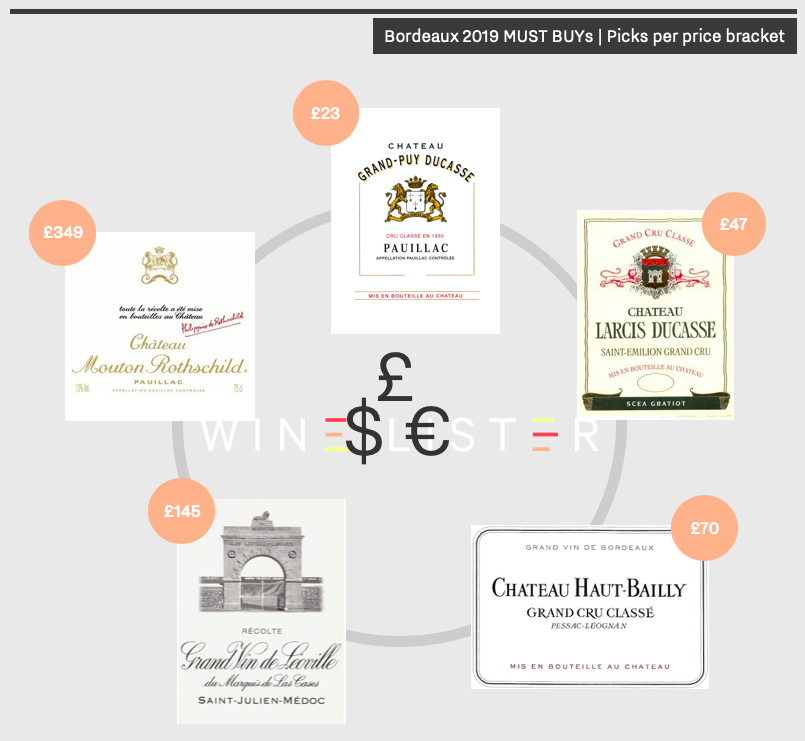
Under £25 – Grand-Puy-Ducasse
Grand-Puy-Ducasse 2019 is both a MUST BUY and a Value Pick, achieving its best ever WL score of 93 in 2019, available at £23 per bottle (in-bond) when buying by the case. The latest release illustrates the contrasting climatic conditions of 2019, with critics noting its complexity and nuance. Wine Lister partner critic, Neal Martin, notes, “crisp tannins, a fine bead of acidity, cohesive and harmonious with a lovely saline/briny note”, adding “this is one of the best Grand Puy Ducasse wines that I have encountered from barrel. Excellent”. Grand-Puy-Ducasse 2019 is available to purchase by the case from Justerini & Brooks.
More Bordeaux 2019 MUSY BUYs under £25: Capbern, Gloria, Laroque, Meyney, Potensac, and Siran.
Under £50 – Larcis-Ducasse
At £47 per bottle (in-bond), Larcis-Ducasse 2019 is priced notably well within the wider context of Saint-Émilion Grand Cru Classé “B” releases. As examined in a recent en primeur blog, it earns a WL score of 95 – just one point less than the likes of Cheval Blanc and Pavie (costing on average six times less than its Classés “A” neighbours). Winemaker, David Suire, observes that the vintage reflects clearly its limestone terroir, showing floral notes and an overriding minerality. Wine Lister partner critic, Antonio Galloni, concurs, noting “graphite, menthol, licorice, tobacco and cedar notes” in the bouquet, coining it “one of Bordeaux’s most under the radar gems”. While demand for this wine has likely been strong, Larcis-Ducasse 2019 is still available through Millésima’s UK and Hong Kong branches.
More Bordeaux 2019 MUST BUYs under £50: Brane-Cantenac, Giscours, Grand-Puy-Lacoste, La Gaffelière, Malescot Saint-Exupéry, and Pavie-Macquin.
Under £100 – Haut-Bailly
At £70 per bottle (in-bond), Haut-Bailly 2019 shares the château’s top WL score (95) with recent vintages 2018, 2016, 2015, and 2014. Managing Director, Veronique Sanders, told the Wine Lister team of their need to light fires five times to prevent frost in the spring of 2019, escaping unscathed. In the end, challenges throughout the growing season concluded in perfect harvest conditions, and a wine of impressive balance and energy. Indeed, the 2019 has received unanimous confidence from critics – Neal Martin states that the 2019 is a “more terroir expressive Haut-Bailly that has an effortless allure and a sense of sophistication”, concluding that it is “wonderful”. Haut-Bailly 2019 can be acquired by the case through Goedhuis & co.
More Bordeaux 2019 MUST BUYs under £100: Calon Ségur, Canon-la-Gaffelière, Canon, Clinet, Léoville Poyferré, Pontet-Canet, Lynch-Bages, Montrose, and Troplong-Mondot.
Under £200 – Léoville Las Cases
Léoville Las Cases 2019 achieves a WL score of 97, at £145 per bottle (in-bond). While volumes of the 2019 released onto the market were down 35% on last year, there is still some availability of this Saint-Julien super second, and we highly recommend getting your hands on some. Wine Lister’s CEO, Ella, describes it as “luminous and lyrical”, noting a bouquet of “English garden – raspberry blossom, cow parsley, fraises de bois, and then a deeper note of ripe cherries”. James Lawther for JancisRobinson.com is similarly impressed, awarding it 19 points and noting it as “one of the greats from this estate”. The latest vintage can be purchased through Fine+Rare.
More Bordeaux 2019 MUST BUYs under £200: Figeac, Haut-Brion, La Conseillante, La Mondotte, Le Petit Mouton, La Mission Haut-Brion, Palmer, Pichon Comtesse, and Vieux Château Certan.
Over £300 – Mouton
While the release price of this Pauillac Premier Cru, let alone the quality of its 2019, likely makes it one of the most popular buys of the campaign, there may still be opportunities to secure some en primeur. Released at £299 per bottle (in-bond), Mouton 2019 achieves a WL score of 97 – the second-highest score achieved by the château in recent years, following the 2016’s 98. Wine Lister’s CEO, Ella Lister, describes Mouton 2019 thus: “velveteen tannins, long and caressing”, recounting “complex, savoury flavours of graphite and slate intermingled with the generous fruit”. Farr Vintners still appears to have some availability of Mouton 2019 (albeit at a slightly higher price than its release).
More Bordeaux 2019 MUST BUYs over £300: Cheval Blanc, Lafite, and Lafleur.
French readers can find this blog in French translation on Le Figaro Vin’s website.
Wine Lister Pro members can read Part II of the Bordeaux study here. All free users can purchase the report for £125 from Wine Lister’s Analysis page (available in both English and French).
This week, Wine Lister published Part II of its annual in-depth Bordeaux Study, In sickness, in health, which, among other inquiries, examines the 40 top-quality crus in 2019. As illustrated in the study, tastings have so far indicated high quality levels across the board in 2019, while numerous wines have made significant advancements, shaking up this year’s rankings.
Following this line of investigation, below we examine the top 25 Bordeaux 2019s by WL score (as separated by mere decimals), and consider the biggest movers since last year. These scores are informed by the recently-released ratings of Wine Lister partner critics, Bettane+Desseauve, Antonio Galloni and Neal Martin for Vinous.com, and James Lawther for JancisRobinson.com.
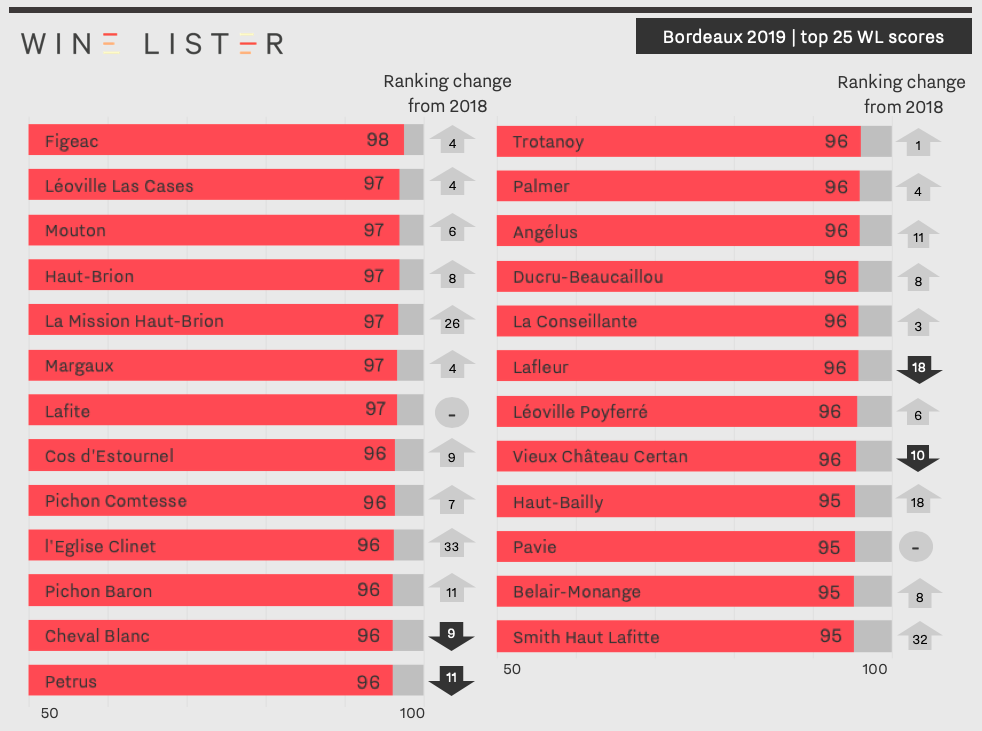
Consistent with last year’s ranking of Bordeaux 2018s by Quality score (conducted before the introduction of Wine Lister’s free site, featuring WL scores out of 100), Pomerol earns the highest number of places (six) in the top 25 2019s by WL score. Neighbouring Saint-Emilion follows closely behind with five spots in this year’s ranking, including the top-scoring wine of the vintage, Figeac 2019, which achieves a WL score of 98.
The four first growths to release their 2019s en primeur appear in third through seventh places, intersected by La Mission Haut-Brion’s entry at fifth place. This promising Pessac-Léognan climbs an impressive 26 spots in 2019, and, as mentioned in our previous blog, has been recently assigned MUST BUY status. Neal Martin scores La Mission Haut-Brion 2019 98-100 points, declaring: “I wager that ultimately this will become one of the wines of the vintage”, concluding that the wine is “breathtaking”.
L’Eglise Clinet sees an impressive upwards shift of 33 places this year, entering the top 10 with a WL score of 96. A poignant tribute to its late winemaker, Denis Durantou, its 2019 has received significant praise, with Antonio Galloni noting that it is “very clearly one of the wines of the year. A Pomerol of soaring, majestic intensity, L’Eglise-Clinet dazzles from start to finish”.
Pichon-Baron and Angélus both climb eleven places in this year’s top-25 ranking, to 11th and 16th place, respectively, with the former receiving top scores from both Neal Martin and Antonio Galloni. Both critics allude to the depth of Pichon-Baron’s 2019, with Galloni stating that “pomegranate, chocolate, licorice and spice are all lavishly expressed”. This represents one of Pauillac’s four entries on this year’s top-25 ranking, which also comprises Mouton, Lafite, and Pichon Comtesse.
Haut-Bailly makes a sizeable leap of 18 places since last year, ranking in 21st place with a WL score of 95. At £70 per bottle (in-bond) Haut-Bailly 2019 is also a Wine Lister MUST BUY. Fellow Pessac-Léognan producer, Smith Haut Lafitte, climbs an impressive 32 places with its 2019 vintage, rounding out the top 25 list. Having tasted twice, Neal Martin describes its “intense, very pure bouquet with blackberry, briary and cherry compote and a hint of black olive tapenade in the background”.
Also featured in the top 25 Bordeaux 2019s by WL score are: Belair-Monange, Cheval Blanc, Cos d’Estournel, Ducru-Beaucaillou, Haut-Brion, La Conseillante, Lafleur, Léoville Las Cases, Léoville Poyferré, Margaux, Palmer, Pavie, Petrus, Trotanoy, and Vieux Château Certan.
Wine Lister Pro members can read Part II of the Bordeaux study here. All free users can purchase the report for £125 from Wine Lister’s Analysis page (available in both English and French).
With the Bordeaux 2019 en primeur campaign now concluded, we bring you 38 new Wine Lister MUST BUYs. The tasting of Bordeaux 2019 has thus far confirmed the notable quality of the vintage, from which we have filtered some obvious campaign buys that can be expected to see increased prices, and decreased availability in the future.
Wine Lister’s MUST BUY recommendation algorithm takes into account a wine’s quality and value within its vintage and appellation, as well as the latest industry intelligence from key players in the global fine wine trade. These results are then filtered through an intelligence-based, human overlay, which identifies MUST BUY wines based on our tasting of Bordeaux 2019, and observation of the reception of each release in the market.
As illustrated below, there are 38 Bordeaux 2019s that are now recognised as MUST BUYs – suggesting that the benefit of buying en primeur is more obvious than last year (there were 24 Bordeaux 2018 en primeurs recognised as MUST BUYs following its campaign). They are all red:
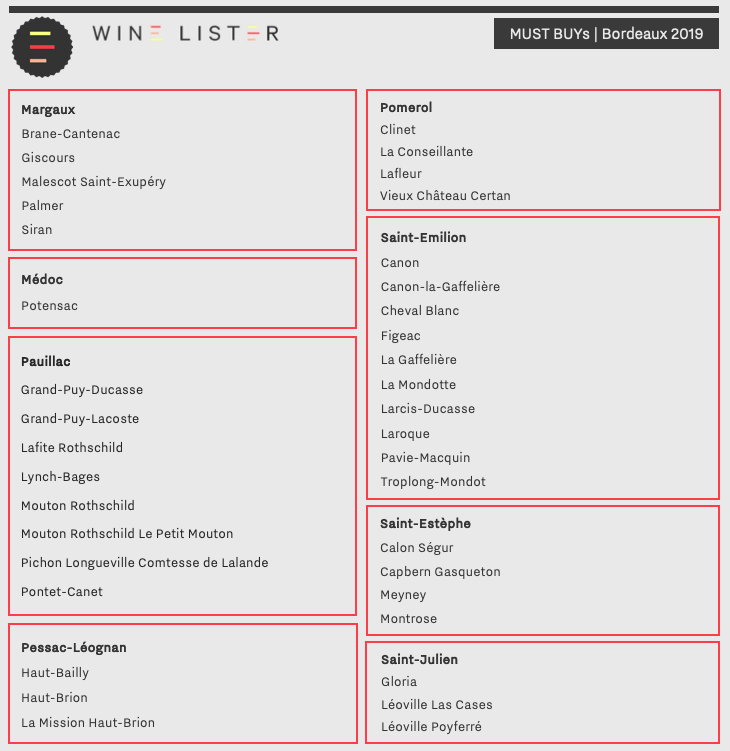
In keeping with last year’s MUST BUY picks, Saint-Emilion once again ranks as the most recommended appellation – this year offering 10 MUST BUYs, including the top-scoring wine of the vintage: Figeac 2019. With a WL score of 98, Figeac’s latest vintage has sustained the château’s upward quality trajectory.
With a WL score of 93 at £18 per bottle (in-bond), Laroque 2019 exhibits excellent value relative to 2019 Saint-Emilions of comparable quality. Alongside its MUST BUY status, Laroque’s latest vintage is also a Value Pick, making it an essential acquisition for the savvy Bordeaux buyer. Wine Lister partner critic, Antonio Galloni, notes, “raspberry jam, spice and red plum meld into the juicy finish”, stating that “the 2019 is very nicely done”.
Pauillac houses eight Bordeaux 2019 MUST BUYs, including first growths Lafite and Mouton, which both achieve WL scores of 97. Grand-Puy-Ducasse 2019 is both a MUST BUY and a Value Pick, having achieved a WL score of 93 at £23 per bottle (in-bond). Writing for Jancisrobinson.com, James Lawther muses whether the 2019 is the, “best of recent vintages?”, suggesting that it “certainly has more structure and power with additional mid-palate flesh”. As proposed in a previous Bordeaux 2019 en primeur blog, Pichon Comtesse is another notable Pauillac purchase for wine collectors, given the estate’s impressive popularity, and its vast reduction in volume released this year.
Within its five MUST BUY picks (four at under £50 per bottle in-bond), Margaux contains two Value Picks, with Malescot Saint-Exupery and Siran priced at £31 and £20 per bottle (in-bond), respectively. At £167 per bottle (in-bond) Palmer 2019 shows good value within the context of its previous vintages (31% below the 2018 and 2016 release prices), which, alongside its limited quantity released en primeur, makes this a must for Margaux enthusiasts.
In Pomerol, La Conseillante, Lafleur, and Vieux Château Certan achieve WL scores of 96, while Clinet follows shortly behind with 95. At £54 per bottle (in-bond) the latter is notably cheaper than its Pomerol peers, and has made a major leap up in quality from previous vintages. Awarding it 97-99 points, Neal Martin writes that Clinet 2019 “is just so fragrant on the nose”, stating that, “the purity that Ronan Laborde and his team have achieved should be applauded”.
Calon Ségur and Montrose lead Saint-Estèphe’s four MUST BUYs with a shared WL score of 95, while Meyney and Capbern provide testament to the value proposition available in the appellation, having been priced at £19 and £15 per bottle (in-bond), respectively.
Sharing three picks apiece are further left bank appellations Saint-Julien and Pessac-Léognan, which are both home to high-scoring 2019s. In Saint-Julien, Léoville Las Cases achieves a WL score of 97 – matched by Pessac-Léognan first growth Haut-Brion, and neighbour, La Mission.
Other wines featured in Wine Lister’s Bordeaux 2019 MUST BUYs are: Brane-Cantenac, Canon, Canon-la-Gaffelière, Cheval Blanc, Giscours, Gloria, Grand-Puy-Lacoste, Haut-Bailly, Le Petit Mouton, La Gaffelière, La Mondotte, Larcis-Ducasse, Léoville Poyferré, Lynch-Bages, Pavie-Macquin, Pontet-Canet, Potensac, and Troplong-Mondot.
Wine Lister has now released Part II of its annual in-depth Bordeaux Study, examining the price and quality of Bordeaux 2019, relative to previous vintages. Purchase the full report here, or download using your Pro subscription (available in both English and French).
Since the last update, some 34 further Bordeaux 2019s have been released en primeur, covering a wide range of styles and price points. Given the saturation of releases, below we highlight a small selection of wines particularly worth backing.
Big hitters
La Conseillante opened the stage of en primeur week three – “mega Monday”, releasing its 2019 at £126 per bottle. Wine Lister’s CEO, Ella Lister, notes the wine is “vibrant, with a playful bouquet of spice, tobacco, and pure dark fruit”. Wine Lister partner critic, Neal Martin agrees, awarding the 2019 its highest ever Vinous score (97-99), and noting, “Winemaker Marielle Cazaux and her team have conjured a magnificent Pomerol here”. Coming onto the market 25% below 2018’s release price, this is worth snapping up given its continuation of La Conseillante’s style evolution – indeed, the wine still provides good value when compared to other Pomerols of similar quality.
Figeac followed closely behind, releasing its 2019 at an identical price. Also entering the market 25% below the 2018 (the most expensive recent Figeac vintage on the market), it too continues its upward quality trajectory in spectacular fashion. Awarding it the same score as La Conseillante, Martin names it “a deeply impressive, intellectual Figeac…amongst the canon of greats that stretch back to the 1940s”. Figeac was a Wine Lister favourite in 2018, and has clearly done another spectacular job this year – this is an absolute buy to put away for the future.
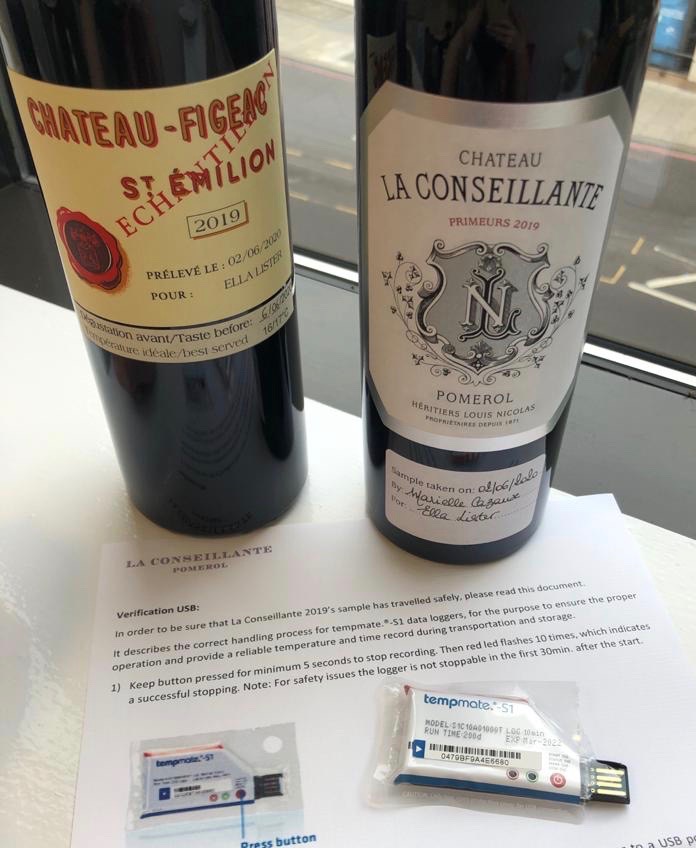
Arriving with a clever digital temperature checker – Wine Lister CEO, Ella Lister, tastes La Conseillante and Figeac samples in London.
Montrose 2019 was released this morning (Tuesday 16th June), at just over £100 per bottle (in-bond). While the wine has not yet been widely rated, Ella Lister tasted at the property last week, and names the 2019 “very harmonious, calming, and hypnotic”, with a “lovely, rounded, succulent, fresh-fruit palate”, and “satin tannins”. Continuing Montrose’s legacy of quality excellence, the 2019 is once again a good punt for decadent Bordeaux drinkers.
Old Faithfuls
Giscours 2019 released at £35.20 per bottle (in-bond) on Friday 12th June. Entering the market below current prices of the last five vintages, this should be an obvious buy for fans of the Margaux château. Lister notes the 2019 as “confident and precise” on the nose, and “creamy, accomplished, and long” in the mouth, calling it a “classic Giscours”. Neal Martin, concurs, noting, “this is a superb, potentially long-term Giscours”.
A perennial British favourite, Talbot 2019 has also been released, at an opening price of £35.15 per bottle (in-bond). Lister names Talbot 2019 one of her “coups de coeur”, adding that it is “spicy and exotic”, as well as “fresh and harmonious”. Talbot’s strong brand and visible recent quality improvements make this release a safe bet for any buyer looking for Left Bank Bordeaux to drink in 20-30 years.
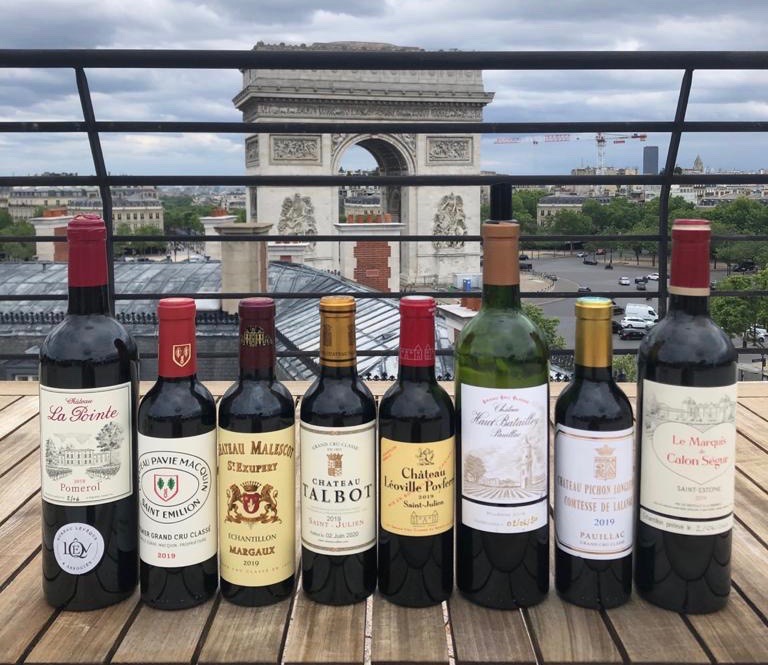 A “grand merci” to négociant Duclot for hosting the recent Bordeaux 2019 en primeur tasting in Paris. Pictured: some of Wine Lister’s CEO, Ella Lister’s favourites.
A “grand merci” to négociant Duclot for hosting the recent Bordeaux 2019 en primeur tasting in Paris. Pictured: some of Wine Lister’s CEO, Ella Lister’s favourites.
Grand-Puy-Lacoste released its 2019 this morning (Tuesday 16th June), at £45 per bottle (in-bond). Another UK favourite, this release has seen some buzz from those trade members who have tasted already, and critics agree – Lister writes that it is “blue fruited, aquiline, pure, and purring”, while Martin (who gives it its best ever score – 95-97), says, “Classy and full of breeding – quintessential Pauillac”. Despite some availability of recent back vintages – 2015 and 2014 – at a similar price (or indeed cheaper), this is still a solid bet for top-quality Pauillac to lay down for the future.
Value buys
Chasse-Spleen, a traditional value hit among claret buyers, released its 2019 on Friday 12th June. It enters the market at £20 per bottle (in-bond), a neat 30% below the current market price of the 2018. Neal Martin awards the 2019 a score of 92-94 – placing its quality in line with the 2016 (93 points), with the potential for it to become even better in the future.
Lafon-Rochet released its 2019 yesterday, at £28.30, 12% below the current market price of the 2018. Neal Martin’s score of 93-95 suggests the Saint-Estèphe property has made another quality step up in 2019. Martin notes, “it is imbued with a sense of nobility and classicism that I much admire”. While the “discount” on 2018’s release price is not as high as some may have wished for, Lafon-Rochet 2019 still looks like a bargain relative to other Left Bank wines of similar quality.
Gloria 2019 was released this morning, at £25.10 per bottle (in bond). While only 13% below the current market price of the 2018, the 2019 still provides excellent value relative to other Saint-Julien wines, particularly considering its quality in 2019. Neal Martin awards it 93-95 points, and says, “this is a nimble Saint-Julien, athletic in build with a sapid finish that urges you back for another sip. Excellent”.
Also released over the last few days are the following 2019s: Beauregard, Blason d’Issan, Certan de May, Connétable de Talbot, d’Issan, de Sales, du Tertre, Feytit-Clinet, Fourcas Hosten, Grand Corbin-Despagne, Gruaud-Larose, La Dame de Montrose, La Fleur-Pétrus, La Pointe, La Violette, Lacoste Borie, Lagrange, Le Gay, Les Cruzelles, Montviel, Pape Clément, Pape Clément Blanc, Prieuré-Lichine, Sarget de Gruaud-Larose, and Saint-Pierre.
Today is the 12th working day since the first major 2019 en primeur release, and over 60 wines are already out.
Among others, the last couple of days have seen the 2019 release of another first growth, a Pauillac powerhouse brand, and a major up-and-comer.
Haut-Brion released its red and white grands vins yesterday, at £295 and £560 per bottle in-bond respectively. While the red enters the market a solid 25% below the current market price of the 2018, the white is the campaign’s most expensive wine yet, and offers a smaller discount, of 5% on 2018.
Following Mouton Rothschild’s lead, Haut-Brion’s red looks well-priced within the current economic context, though buyers may note that the 2014 is available on the market around the same price. The 2012 also looks good – earning a WL score of 96, it is a Wine Lister MUST BUY (and available for c.£260 per bottle in-bond).
Also released from the Clarence Dillon family are Haut-Brion’s baby brother, Le Clarence (at c.£100 per bottle in-bond), and cousins La Mission Haut-Brion red and white. Of the two flagship reds, Haut-Brion is likely the stronger horse to back, based on its first growth status, as well as its position according to the trade among top Bordeaux wines for future prestige (see below).
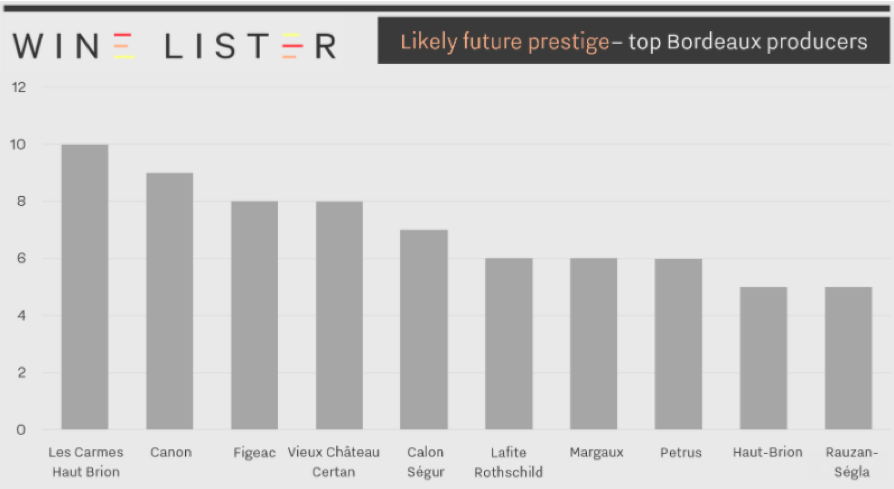 According to Wine Lister’s 2020 trade survey, Haut-Brion is one of top Bordeaux wines most likely to be worth including in collectors’ future cellars.
According to Wine Lister’s 2020 trade survey, Haut-Brion is one of top Bordeaux wines most likely to be worth including in collectors’ future cellars.
Three further pairs of releases from Pessac-Léognan have emerged over the last two days, comprising Malartic-Lagravière, Latour-Martillac, and Carbonnieux.
On Thursday 10th June, Pauillac star-brand Lynch Bages was released, and has resulted in an onward UK selling price of c.£66 per bottle in-bond. Wine Lister’s CEO, Ella Lister, tasted it last week, and found it to be “lifted, precise”, and “a classic”. The price positioning under £70 has reportedly been well-received.
Haut-Batailley was also introduced to the market, at £36 per bottle in-bond. As its second en primeur release under Cazes ownership (the same family as Lynch Bages), the 2019 is 20% under the current market price of the 2018. Following a repositioning of Haut-Batailley’s pricing during en primeur last year, the 2019 release looks good value – the wine’s strong reputation will likely only become stronger with a new wave of investment, and prices are likely to rise accordingly. Lister describes Haut-Batailley 2019 as “pretty”, “elegant”, and “very harmonious”, with a “long, saline, dark chocolate finish” – this is a wine to buy now.
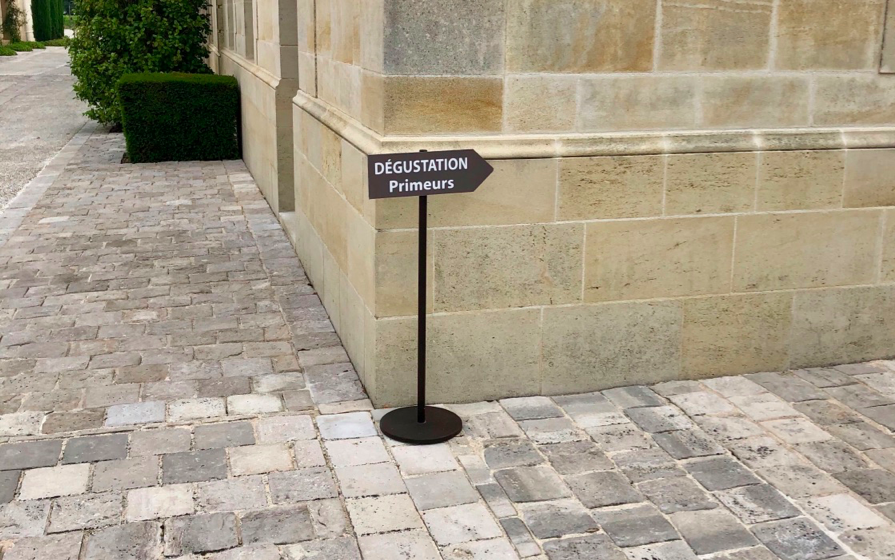 Better late than never – Wine Lister’s CEO, Ella Lister, has now tasted the majority of Bordeaux 2019s. Watch this space for her favourites, and Bordeaux 2019 MUST BUYs coming soon.
Better late than never – Wine Lister’s CEO, Ella Lister, has now tasted the majority of Bordeaux 2019s. Watch this space for her favourites, and Bordeaux 2019 MUST BUYs coming soon.
One further release for each side of the river caught Wine Lister’s eye this week: La Gaffelière 2019 was released 13% beneath the current 2018 market price. The château’s director, Thomas Soubes, told Wine Lister that he was very happy with the quality of their 2019, and Lister concurs – she finds the wine “serious” and “charming”, with “velvet tannin” and “seductive red fruit”. La Gaffelière continues to present excellent value for its impressive quality, relative to wines sharing the Saint-Emilion Grand Cru Classé “B” classification.
Calon Ségur 2019 was also released yesterday. As one of the top rising stars of Bordeaux, its 2019 came onto the market 10% below the 2018 release price, but crucially 31% below 2018’s current market price. Calon Ségur is one of the “poster children” for the true benefits of buying en primeur. Lister found Calon Ségur 2019 to be “perfumed”, “juicy”, and “unctuous”, with “spice on the mid-palate” and a “saline, super-precise finish”. As ever, this is worth snapping up before its price inevitably increases post en primeur release.
Also released during the same period were: Cantenac-Brown, Capbern, Clos Fourtet, Clos René, Cos Labory, Kirwan, Monbousquet, Moulin Saint-Georges, Pavie, Phélan Ségur, Pibran, and Suduiraut.
Keep up to date with further Bordeaux 2019 en primeur releases through Wine Lister’s dedicated en primeur page.
Now into its second full week, the Bordeaux 2019 en primeur campaign shifted up another gear today, with the release of first growth Mouton Rothschild, and its associated properties.
After the flurry of releases yesterday (Monday 8th June) met with very mixed reviews, Mouton reset the campaign tone, with a price 30% below the current market price of 2018, and under the price of all recent back vintages. Bordeaux buyers no doubt breathed a sigh of relief at the tidy figure – £299 per bottle in-bond – the most obvious buy of the campaign so far (other than Lafleur).
Not only is this release on the money in recognising today’s difficult economic context, as well as Bordeaux’s recent price performance struggles, it also provides a brilliant deal given the reported quality of 2019. Wine Lister’s Founder and CEO, Ella Lister found Mouton 2019 to be floral, elegant, and stately. With a high proportion of Cabernet Sauvignon (90%, vs. an average 83%) it promises a long, prosperous life ahead.
Mouton’s younger sibling, also released this morning, looks equally appealing, if for different reasons. Petit Mouton is one of Bordeaux’s top wines for long-term price performance, and its 2019 release price thus manages to enter the market well under all recent back vintages.
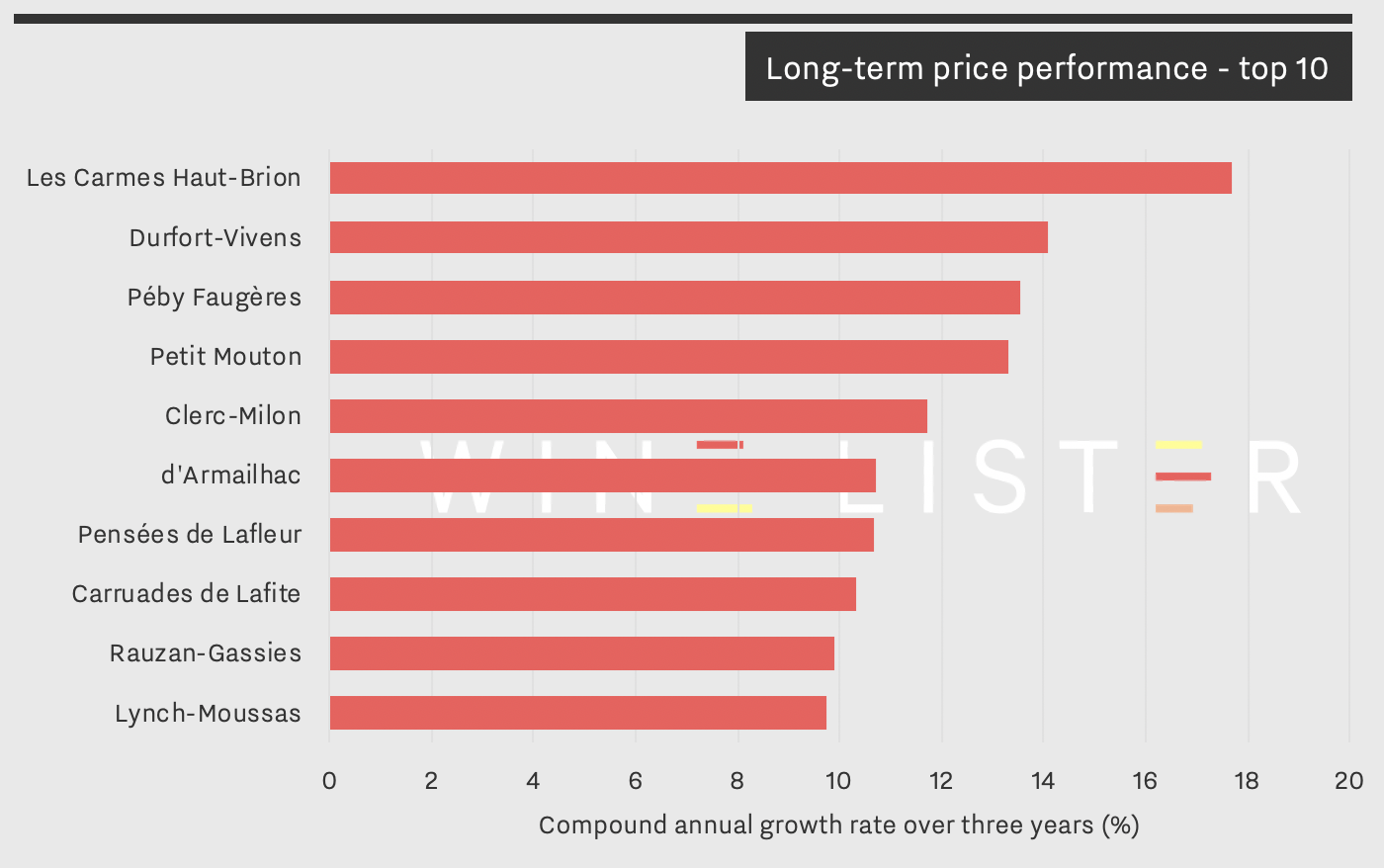 Of major Bordeaux brands, Petit Mouton achieves an average three-year CAGR (compound annual growth rate) of 13.3%, placing it in fourth place of the top 10 long-term price performers, as shown above.
Of major Bordeaux brands, Petit Mouton achieves an average three-year CAGR (compound annual growth rate) of 13.3%, placing it in fourth place of the top 10 long-term price performers, as shown above.
The other 2019s in the Mouton stable, d’Armailhac, Clerc-Milon, and Aile d’Argent were also released today, at prices (per bottle, in-bond) of £31, £52, and £60 respectively.
Yesterday’s hot ticket was right-bank royalty, Cheval Blanc, whose release at £375 also offered consumers a substantial discount on the 2018 release price (32%). Though not yet scored widely by critics, using 2018 as a proxy would mean Cheval Blanc 2019 achieves its joint-highest WL score since the 1961 (alongside the likes of recent greats – 2016, 2015, 2010, 2009, and 2005).
Fellow Saint-Émilion Grand Cru Classé A, Angélus, also released yesterday, though its release price in line with the physically available 2015 perhaps makes it look less attractive. There is nonetheless a real step-change in style and quality happening at Angélus, pioneered by the de Bouärd father-daughter team (Hubert and Stéphanie), which could mean this release is worth investing in for the future.
Two further releases of note from yesterday both hail from Saint-Julien. Branaire-Ducru, a Wine Lister favourite, released its 2019 at £29 per bottle in-bond, 25% down on the 2018 release price. Assuming Branaire’s 2019 is on par with 2018 quality, this is an absolute buy, as the estate’s joint best-ever grand vin at a price beneath all other recent vintages on the market. Léoville-Poyferré 2019 was also released, at £51.34 per bottle in-bond. Offering a 25% discount on last year’s release price for the same quality level, the Saint-Julien second growth is worth considering – having tasted it last week, Lister notes that it is “super-fresh, scented, and luscious”.
Also released so far this week are: Beychevelle, Carillon d’Angélus, Coutet, Gazin, Haut-Bages Libéral, Ferrière, La Gurgue, La Tour Carnet, Larrivet Haut-Brion red and white, and Petit Cheval.
Throughout the late 20th century, Riesling gained a somewhat tarnished reputation, particularly within the UK, as a consequence of the abundance of overly sweet, low-quality Rieslings being released onto the market. Over the past two decades, however, it has made a comeback – especially the dry styles of top-quality wines with ageing potential and great value. The high acidity and complexity of tertiary flavours in Riesling have led to it being a favourite among wine industry professionals, including Jancis Robinson, who hails it “the greatest white wine grape”.
To help you uncover Germany’s noble grape, this week we examine some iconic dry and off-dry Riesling MUST BUYs with WL scores above 95.
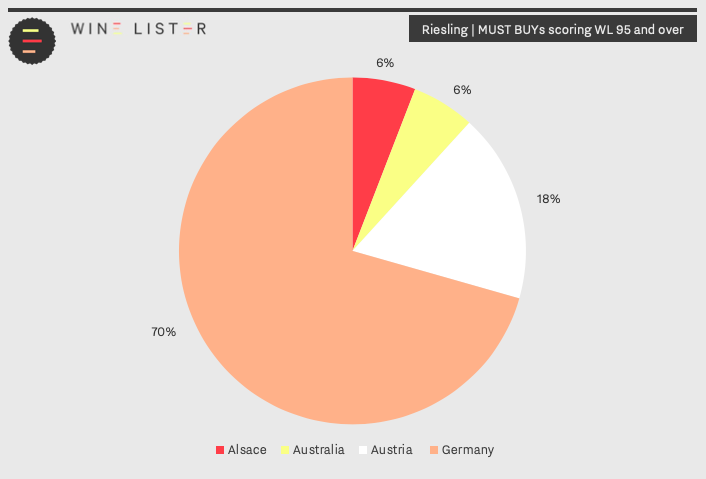
Top quality Riesling is now produced around the world, from the traditional regions of the Mosel and Alsace, through to Australia and South America. 70% of dry Riesling MUST BUYs scoring above WL 95 hail from Germany (25 wines), of which just over half (19 wines) are produced in the Mosel. The other German regions in the list comprise two entries from the Rheinhessen, and one each from the Rheingau, Nahe, and Pfalz respectively.
Austria achieves six entries on the list of Riesling MUST BUYs scoring WL 95 and over (18%), which all hail from Niederösterreich, while the Alsace and Australia’s Clare Valley both earn two entries respectively.
A Mosel Must – 2010 Joh. Jos. Prüm Wehlener Sonnenuhr Riesling Auslese Goldkapsel
With a WL Score of 97 at just £59 (per bottle in-bond), the 2010 Wehlener Sonnenuhr Auslese Goldkapsel exemplifies the excellent quality-to-price ratio of JJ Prüm’s wines. Long considered one of the Mosel’s, if not the whole of Germany’s most revered estates, its Wehlener Sonnenuhr vineyard is situated on steep south-facing, blue slate slopes, resulting in its complex minerality. Scoring it 19/20 points, Wine Lister partner critic, Jancis Robinson recounts that the 2010 vintage of this off-dry Riesling “Dances out of the glass on the nose. Such delicacy and life! Racy”. This vintage is available to purchase from Lay & Wheeler, where a case of six starts at £330 (in bond).
An essential Alsace – 2008 Trimbach Riesling Frédéric Emile
Dating back to 1626, 13 generations of the Trimbach family have contributed to the estate’s winemaking, now considered one of Alsace’s top properties. Cuvée Frédéric Emile is a blend of two Grand Cru vineyards, Geisberg and Osterberg, that share complex soils of alkaline clay and limestone, producing a wine of intense minerality. Both sites benefit from evening winds (the Tahlwendala), which allow extended ripening periods. The 2008 Trimbach Riesling Frédéric Emile achieves a WL Score of 95, and is available to purchase by the case from Cru World Wines for £390 (in bond).
A need for Niederösterreich – 2013 F.X. Pichler Riesling Kellerberg Smaragd
Described by Jancis Robinson as “Big and opulent with some lychee flavours”, the 2013 was a notably good vintage for F.X. Pichler’s Kellerberg Smaragd. Achieving the best WL Score since 1995 (96), it showcases Pichler’s attempt to refine his style and prioritise purity of fruit and balance over power. Although the narrow stone terraces of the Kellerberg vineyard necessitate farming and harvesting by hand, this wine has an impressive quality-to-price ratio. At £34 (per bottle in bond), the 2013 vintage is also a Wine Lister Value pick, and is available to purchase from BI Wines & Spirits (by the case of 12).
A New World necessity – 2013 Grosset Polish Hill Riesling
Often coined one of Australia’s most renowned Riesling winemakers, Jeffrey Grosset’s Polish Hill plot was planted in 1996, following years of research into the effect of soil, rock, and altitude on Riesling. This eight-hectare plot is thus at 460 metres altitude, ensuring cool nights and longer ripening of its Riesling grapes. Planted in an area termed “hard rock”, the Polish Hill vineyard is situated on a crust of clay over slate, which, alongside the cool growing season, causes stress on the vines, resulting in smaller but more complex-flavoured grapes. The 2013 vintage achieves a WL score of 95, and is available to purchase from Lay & Wheeler for £50 (per bottle in bond).
See the full list of Riesling MUST BUYs here.
Following our recent investigation into white Burgundy at five different price points, we now turn to red Burgundy – which represents a considerable 23% of Wine Lister’s MUST BUY hoard (376 wines).
These wines cover an even greater range of prices than their white counterparts, from £51 (per bottle in-bond) up to £15,352. Read on below for our picks of red Burgundy MUST BUYs at five different price points.
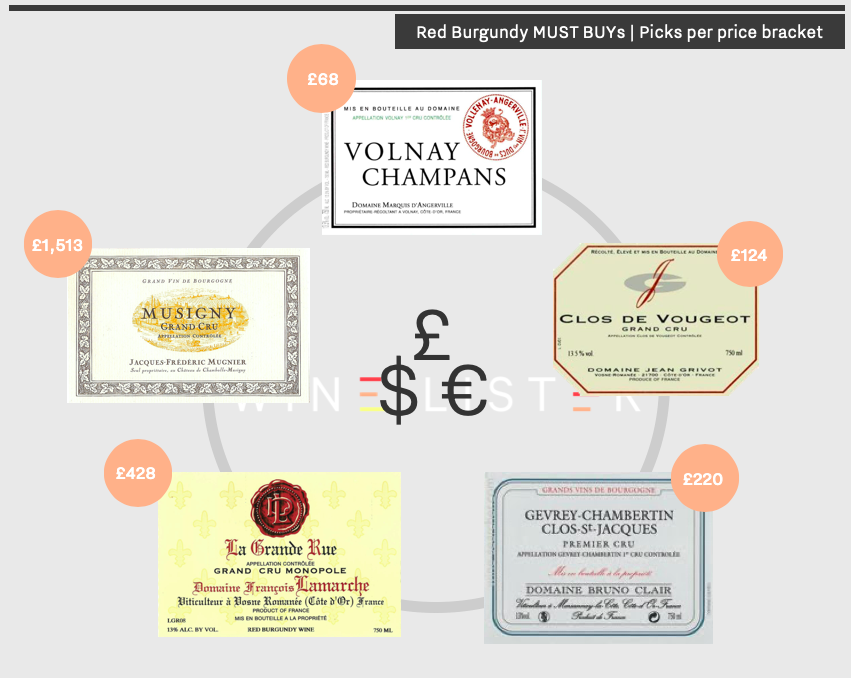 Prices are shown per bottle in-bond (when buying by the case).
Prices are shown per bottle in-bond (when buying by the case).
Under £75 – 2012 Marquis d’Angerville Volnay Champans
Marquis d’Angerville is widely considered one of the top producers in the Côte de Beaune, and the reference producer in Volnay. Indeed, the domain’s vineyards represent over 10% of all Premier Cru Volnay plantings. D’Angerville’s Volnay Champans is less than half of the cost of its flagship Volnay wine, Clos des Ducs. While both vineyards have south-easterly exposure, Clos des Ducs has calcareous, stony, white marl soil, while the soil in Champans is more clay-driven. The Champans is thus richer and fuller, while the Clos des Ducs (which also enjoys the highest elevation in Volnay) has more complexity and definition. The 2012 Marquis d’Angerville Volnay Champans performs particularly well, achieving a WL Score of 94 – this wine can be purchased from BI Wines & Spirits for £66.67 (per bottle in bond).
Under £150 – 2014 Jean Grivot Clos de Vougeot
Having taken over from his father Jean in 1990, Étienne Grivot (alongside his wife Marielle) has since adjusted his family’s viticultural and vinification methods. While completing his studies in general agriculture, viticulture, and oenology, Étienne noted that the over-fertilised Burgundian soil had become gradually less capable of producing vins de terroir. As well as reducing his overall yields, he now uses organic farming methods and natural yeasts to preserve the expression of where the grapes come from. The 2014 Clos de Vougeot has a WL Score of 94, and was described by Jancis Robinson as having “massively nuanced fruit” – this vintage can be purchased by the bottle from Wilkinson Vintners for £124 (in bond).
Under £350 – 2015 Bruno Clair Gevrey-Chambertin Clos Saint-Jacques
Bruno Clair’s Clos Saint-Jacques Premier Cru plantings are situated within a 6.7ha vineyard (shared with Sylvie Esmonin, Louis Jadot, Fourrier, and Armand Rousseau) encircled by a two-metre wall. Providing protection from prevailing winds, this fortification creates a micro-climate, which, alongside its steep south-easterly facing slope, enables consistent ripening. The 2015 vintage achieves a WL Score of 95. Wine Lister partner critic, Neal Martin describes it thus: “a hint of dark chocolate emanates from the oak infusing the red and black fruit toward the finish, and touches of marmalade and blood orange linger on the aftertaste”. This vintage is available to purchase from Cru World Wine, where the price of a bottle starts at £355 (in bond).
Under £500 – 2010 François Lamarche La Grande Rue
Having been elevated to Grand Cru status in 1992, La Grande Rue provides the setting for François Lamarche’s most prized domain – from which only c.5,500 bottles are produced per year. As of the 2007 vintage, François’ daughter, Nicole, has had total control of the winemaking, and has implemented organic viticulture (certified in 2010), which she believes makes vines more resilient to biotic stress. Described by Jancis Robinson as exhibiting “lovely freshness yet concentration and subtlety too”, the 2010 vintage achieves Lamarche La Grande Rue’s highest WL Score since its 1964 vintage (96), and is available to purchase from Corney & Barrow, where prices start at £540 per bottle (in bond).
Over £500 – 2008 Jacques-Frédéric Mugnier Musigny
Jacques-Frédéric Mugnier maintains his aim of preserving the purest expression of nature within his wine, with minimal interference from technological practices in the vineyard or the cellar. His Musigny is widely considered to be one of the greatest Burgundy reds, and has been described by Wine Lister’s Burgundy specialist critic, Jasper Morris as “brilliantly fragrant in bouquet and notably persistent on the finish”. With a WL Score of 96, the 2008 Jacques-Frédéric Mugnier Musigny is more difficult to source than the preceding wines, however, it is worth informing your merchant of your interest in purchasing it.






 A “grand merci” to négociant Duclot for hosting the recent Bordeaux 2019 en primeur tasting in Paris. Pictured: some of Wine Lister’s CEO, Ella Lister’s favourites.
A “grand merci” to négociant Duclot for hosting the recent Bordeaux 2019 en primeur tasting in Paris. Pictured: some of Wine Lister’s CEO, Ella Lister’s favourites.

 Of major Bordeaux brands, Petit Mouton achieves an average three-year CAGR (compound annual growth rate) of 13.3%, placing it in fourth place of the top 10 long-term price performers, as shown above.
Of major Bordeaux brands, Petit Mouton achieves an average three-year CAGR (compound annual growth rate) of 13.3%, placing it in fourth place of the top 10 long-term price performers, as shown above.
